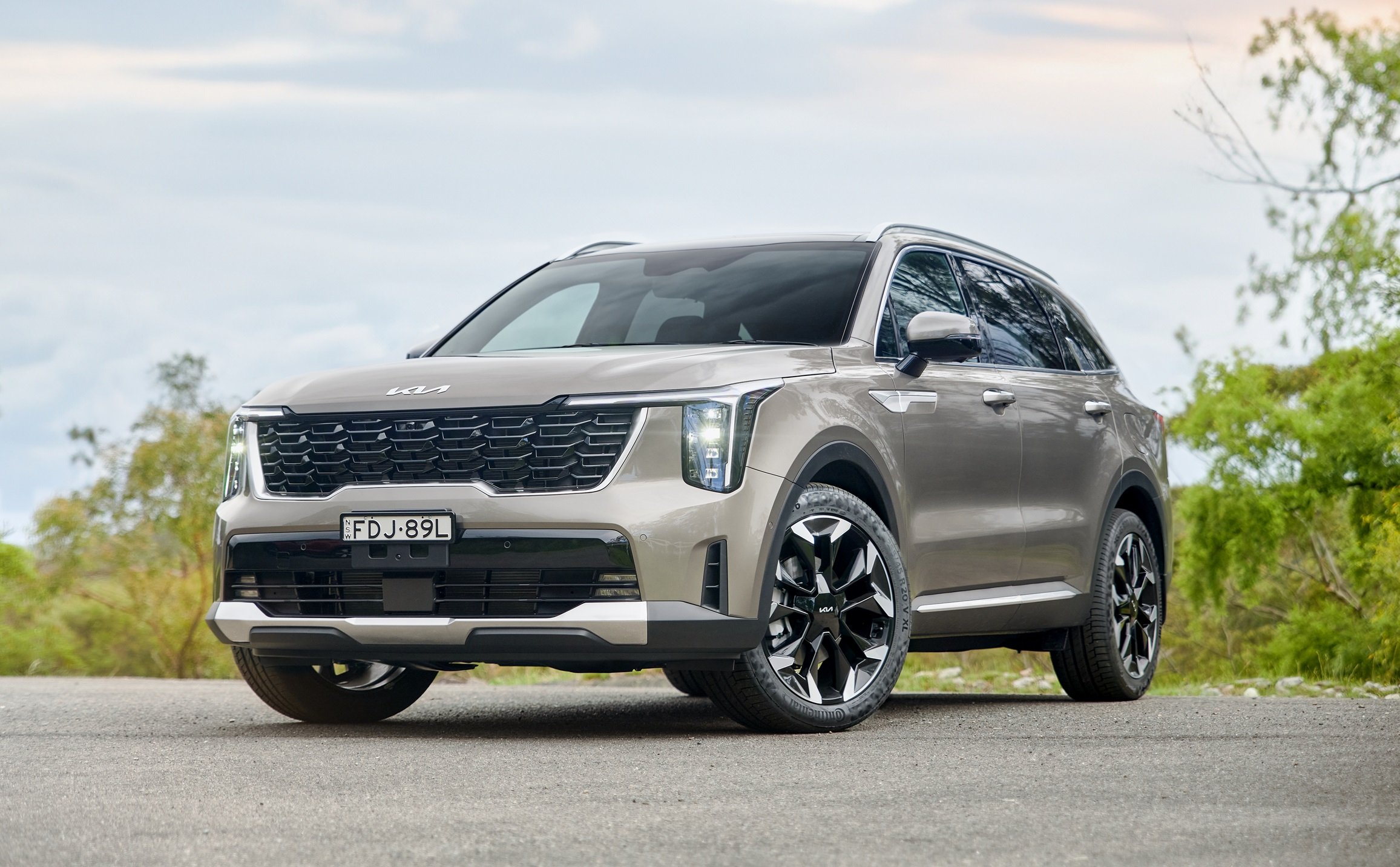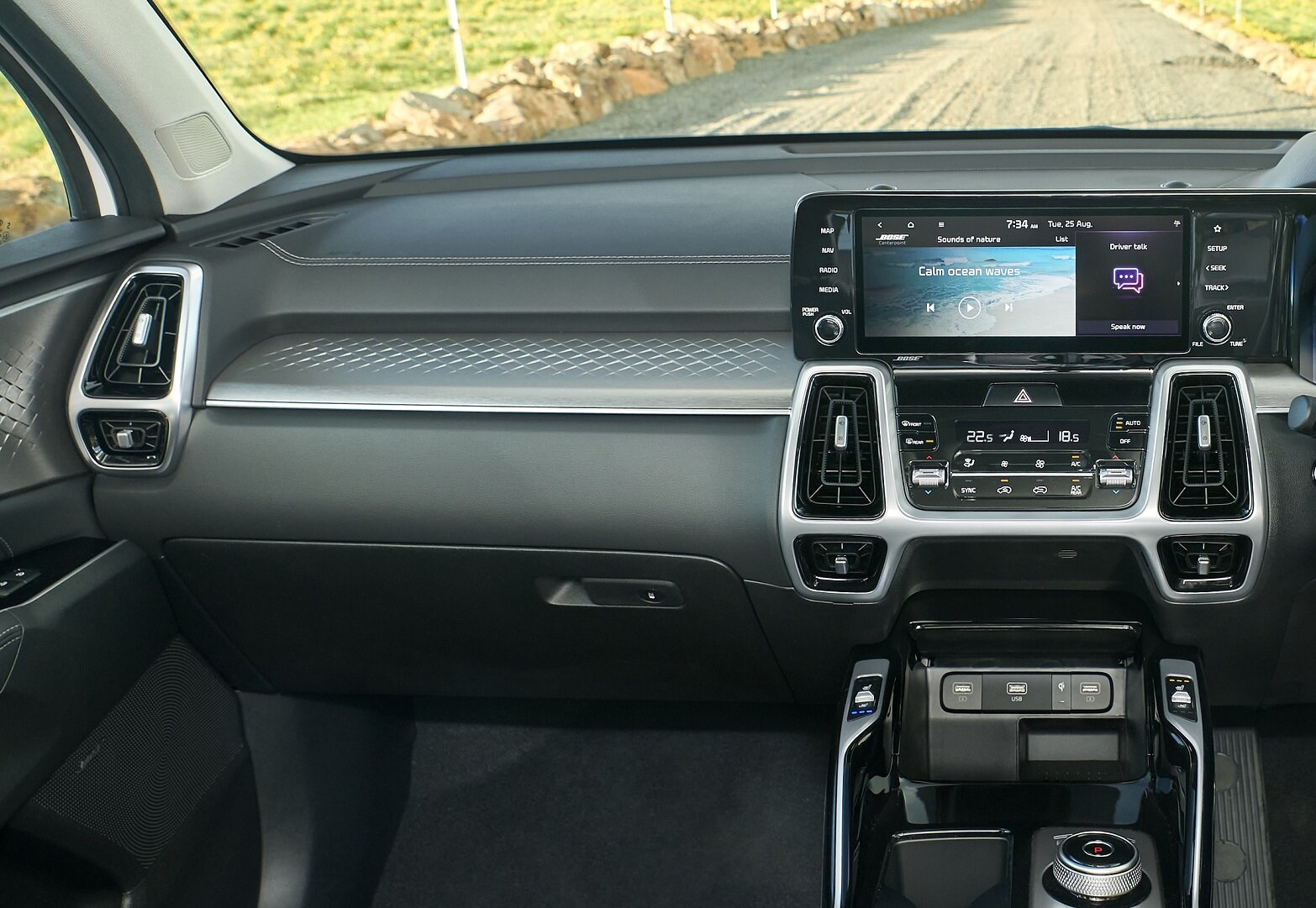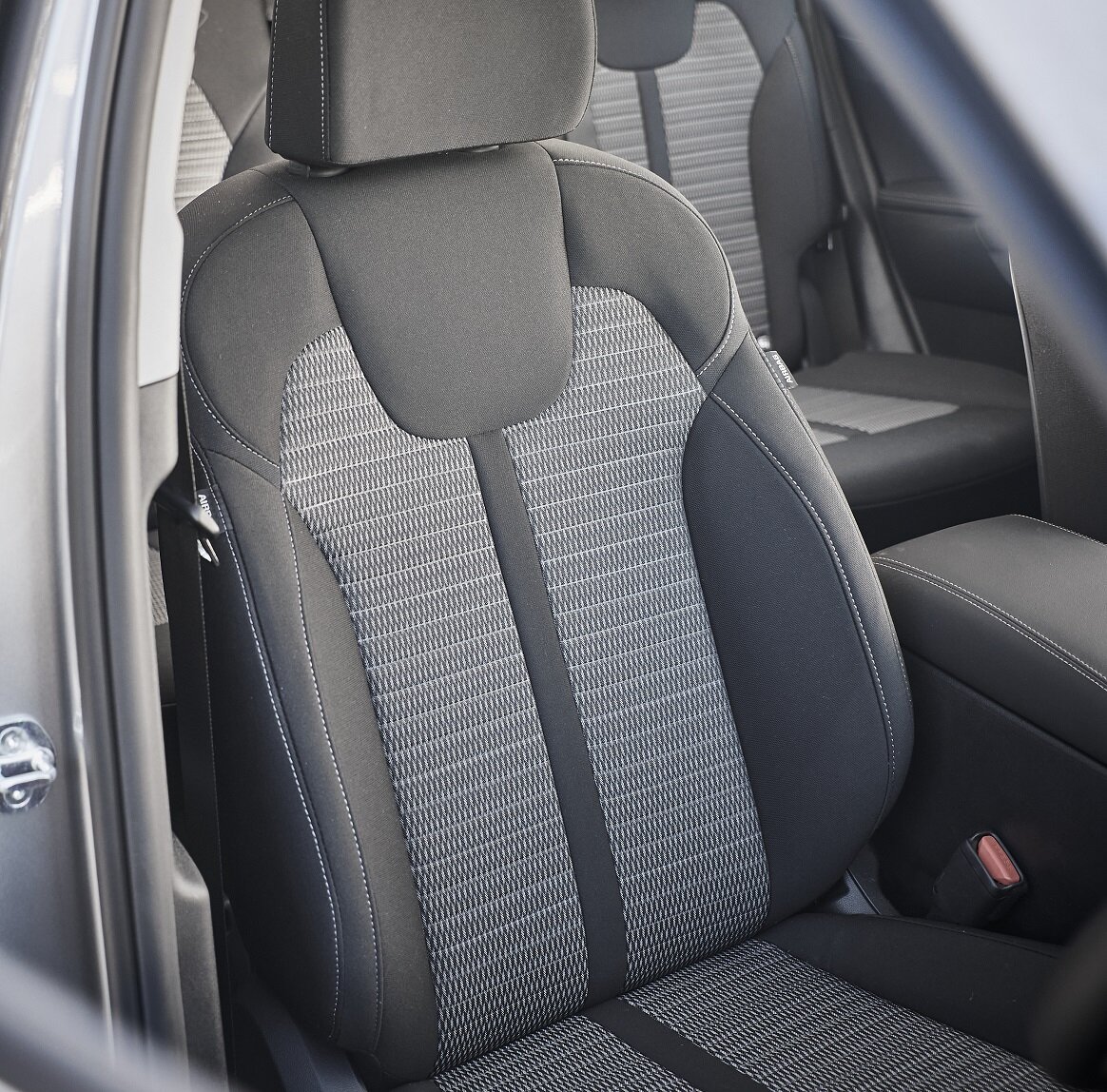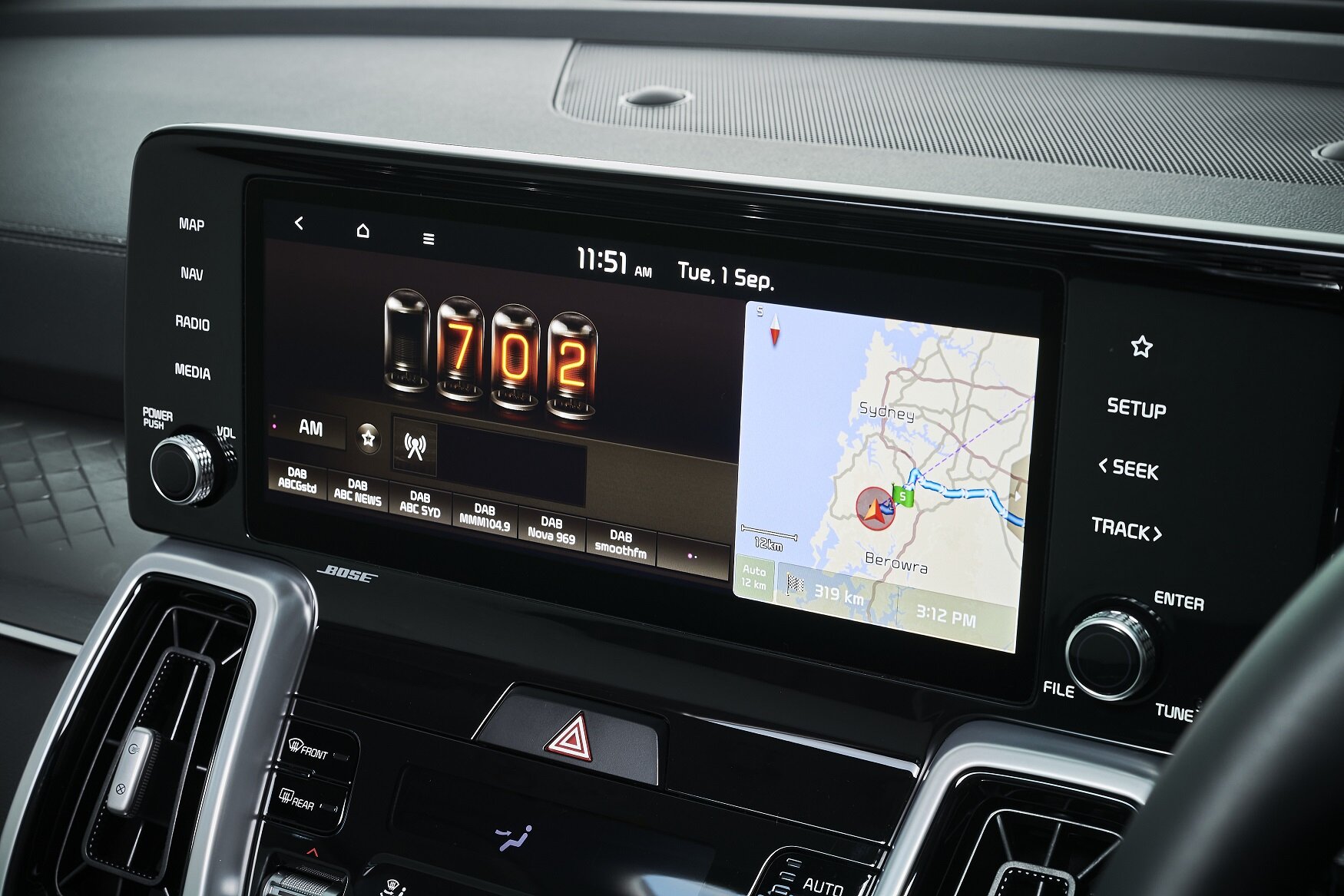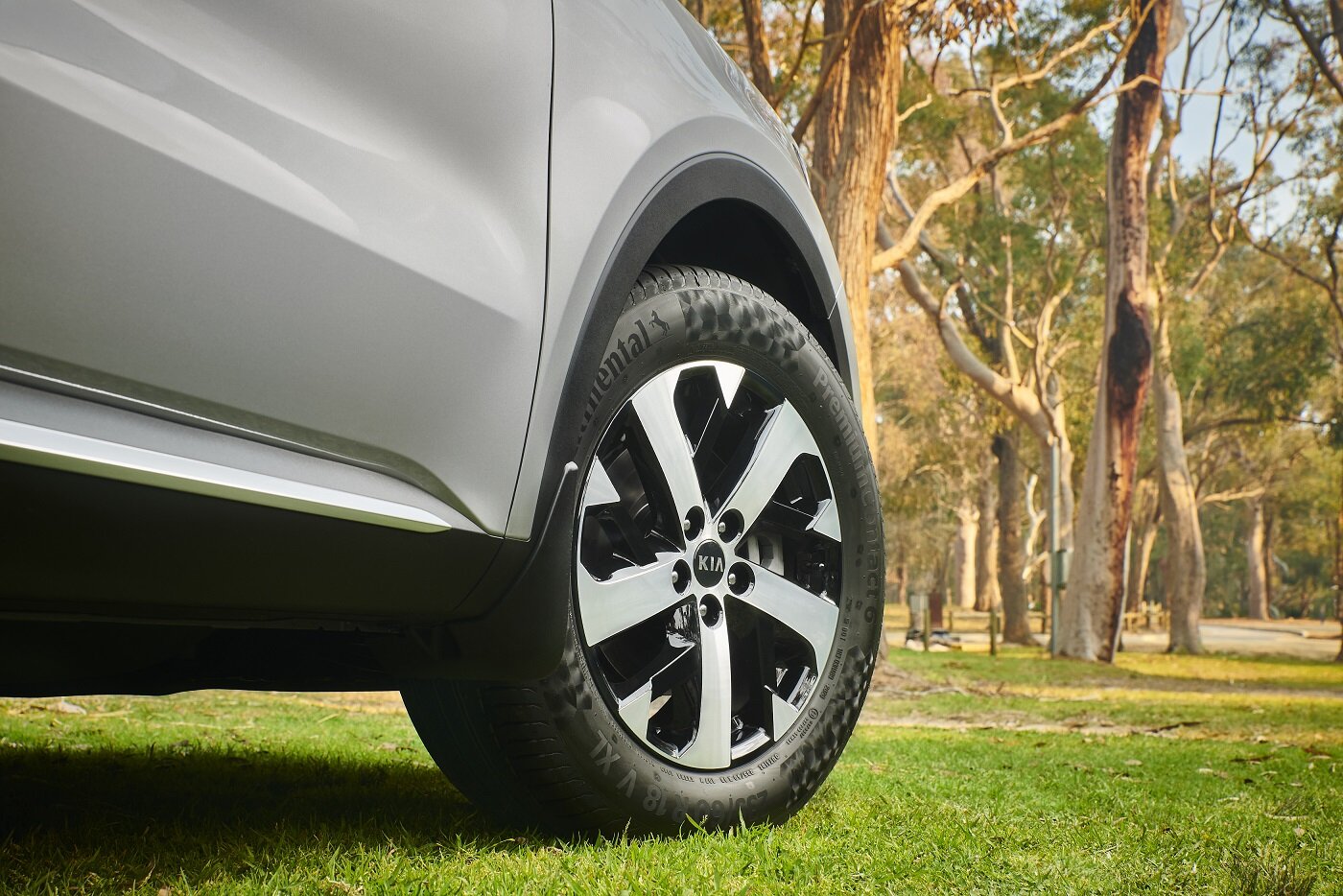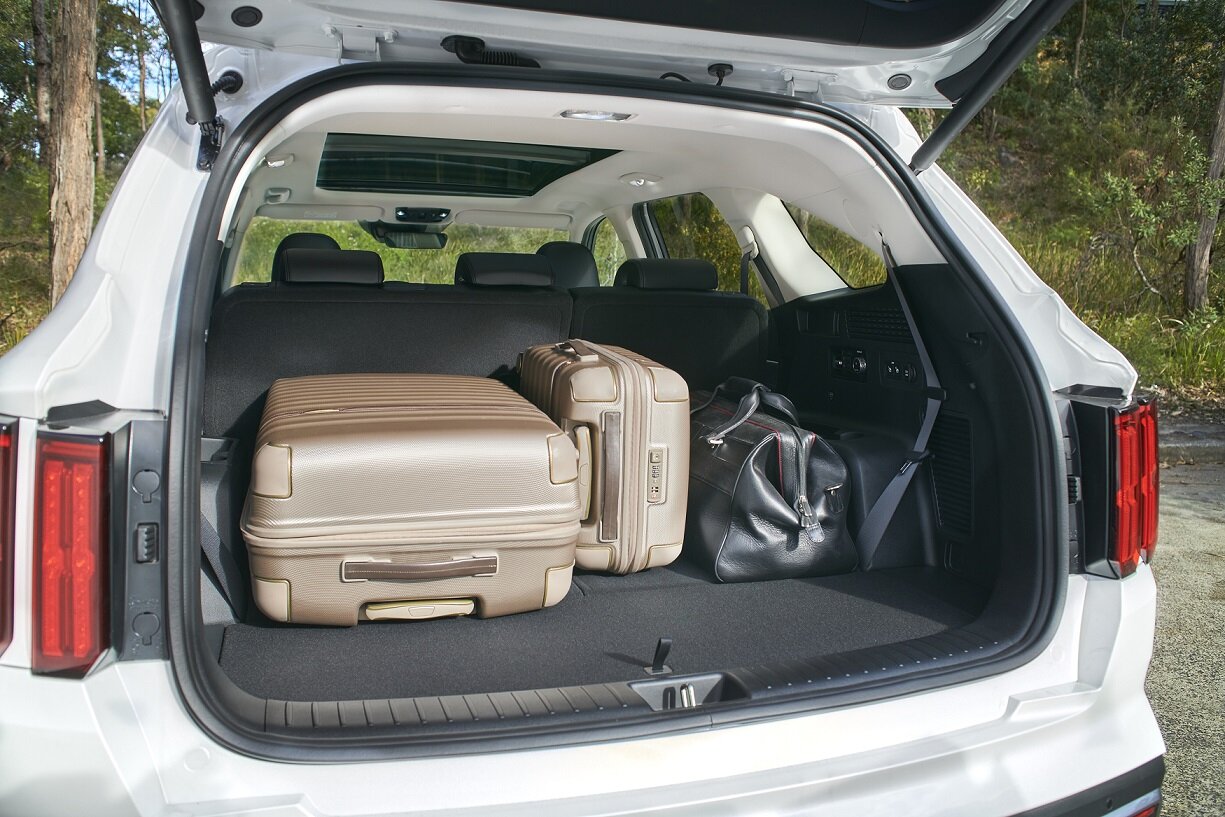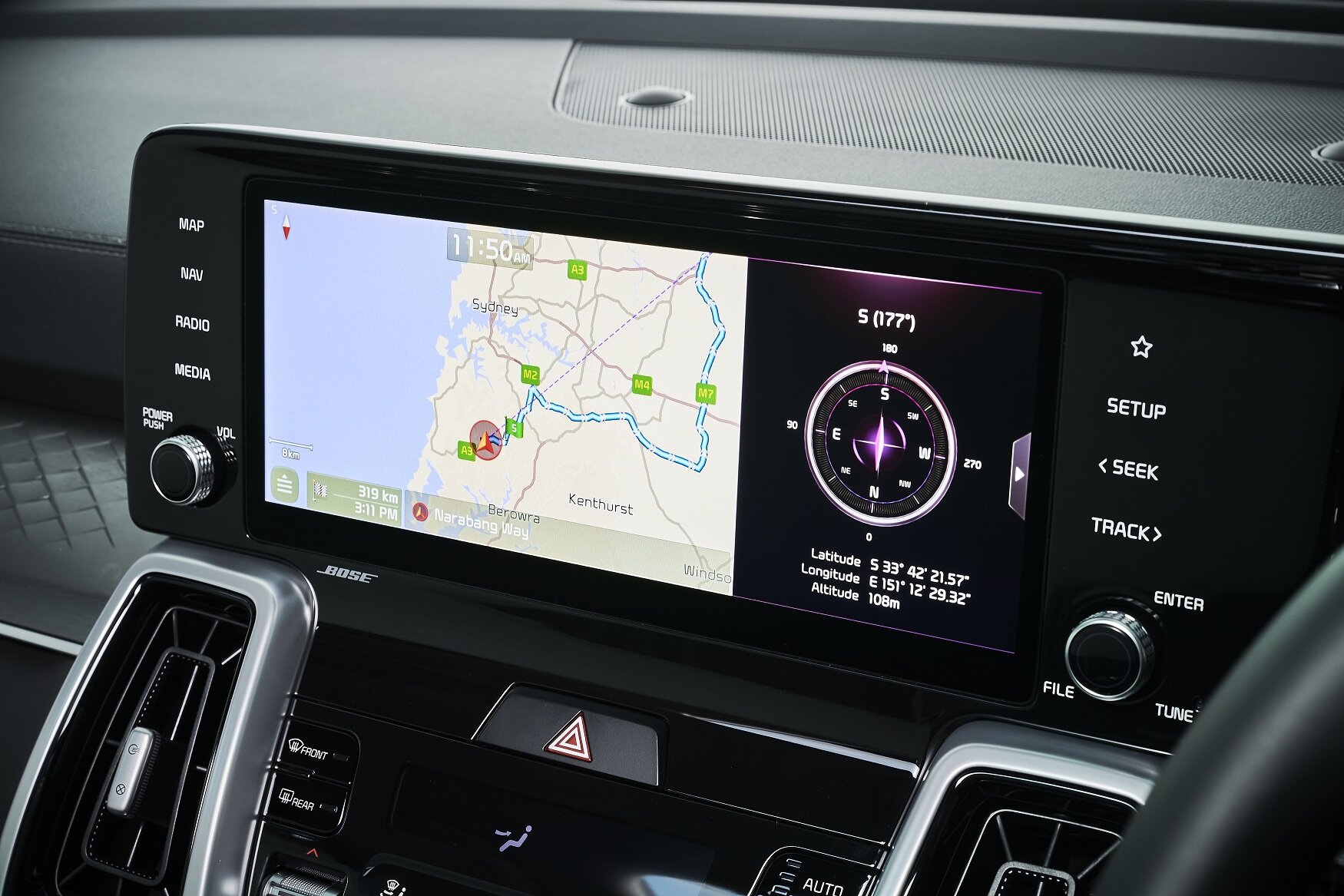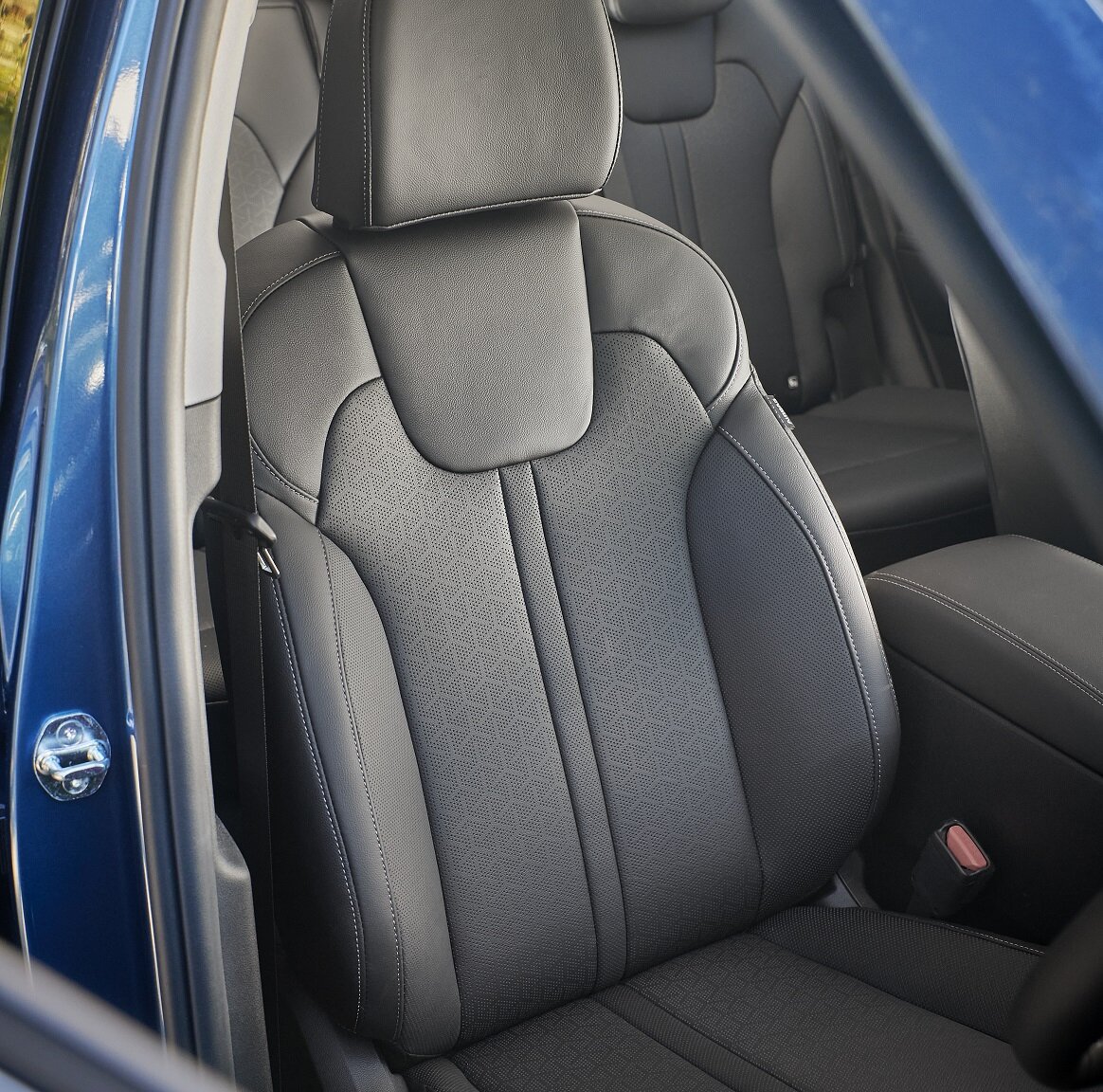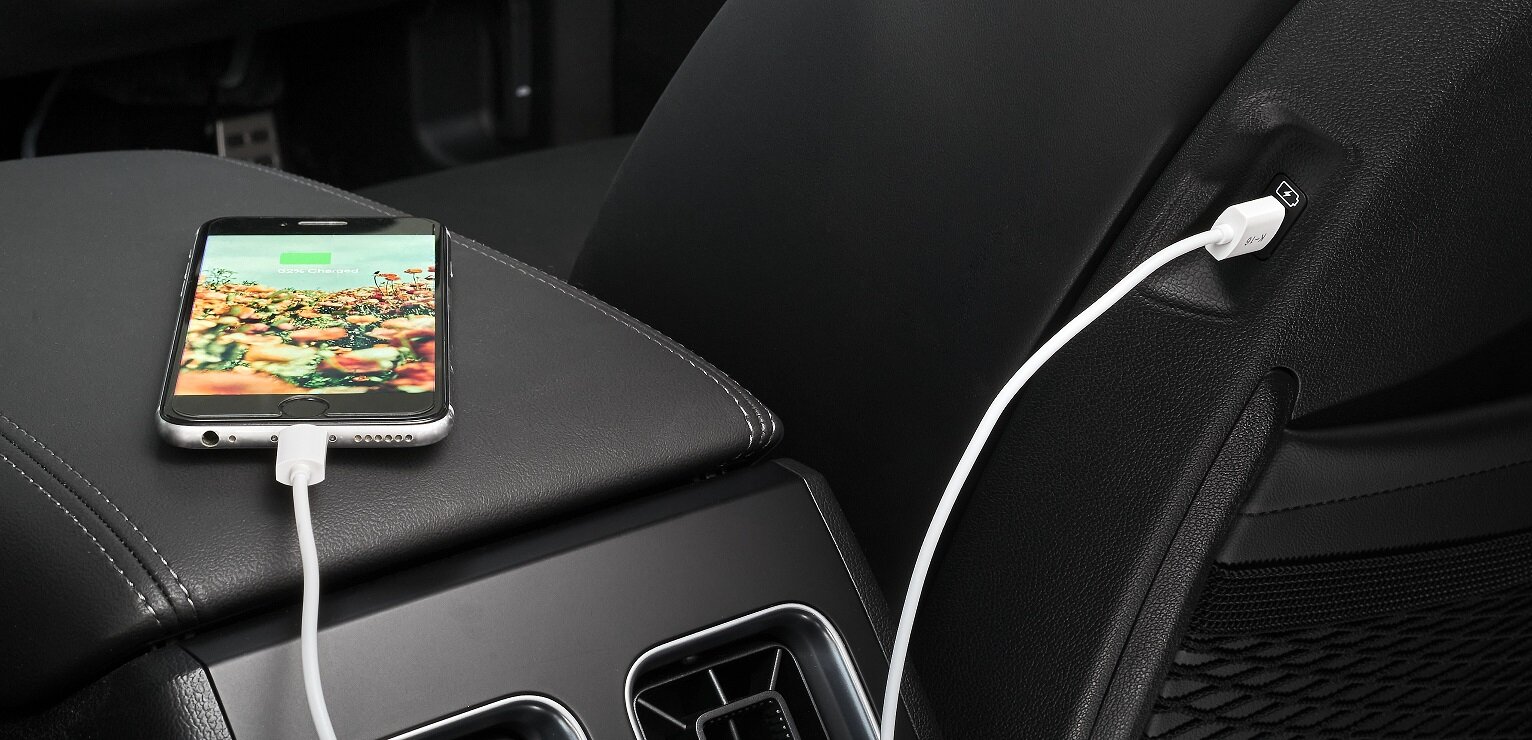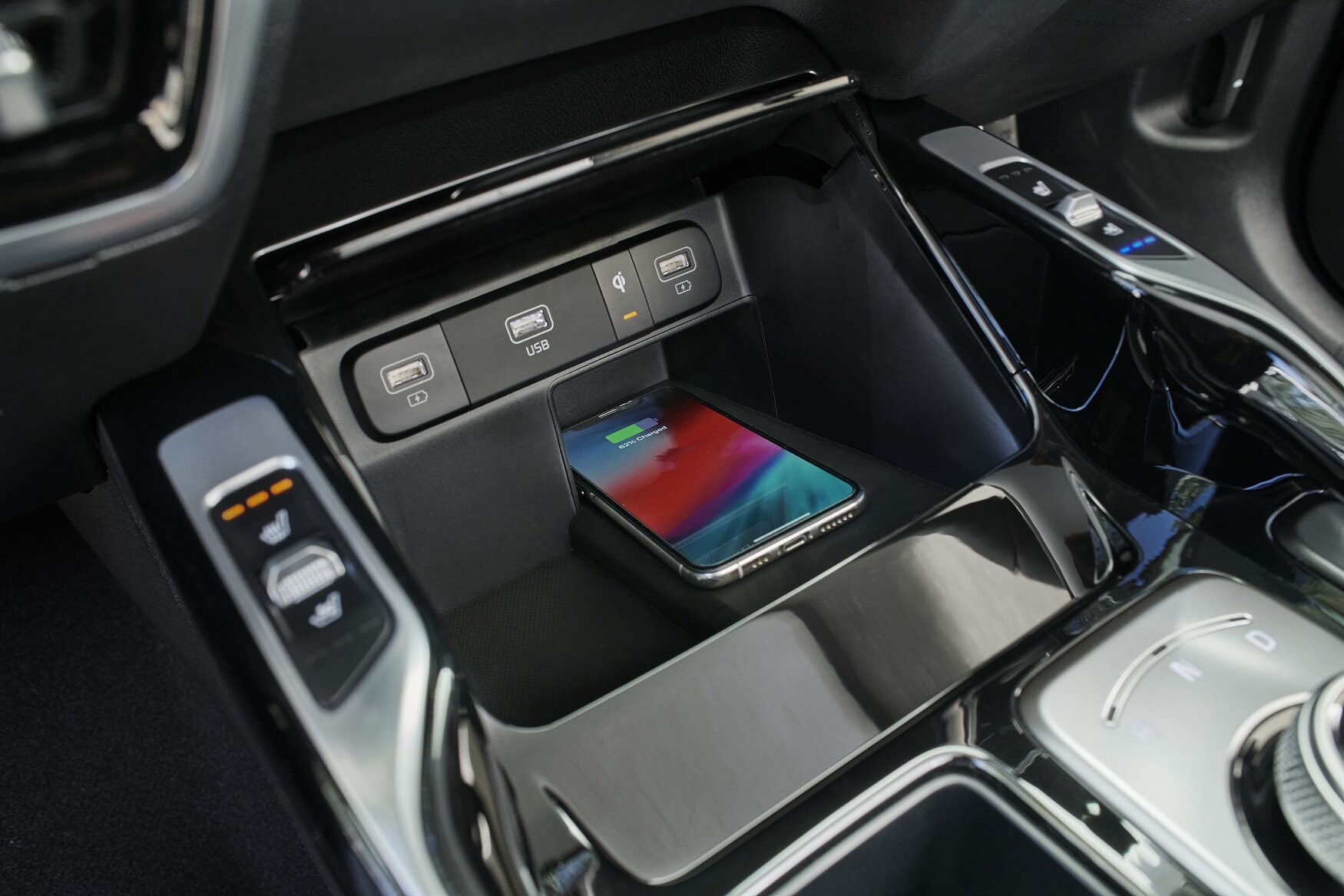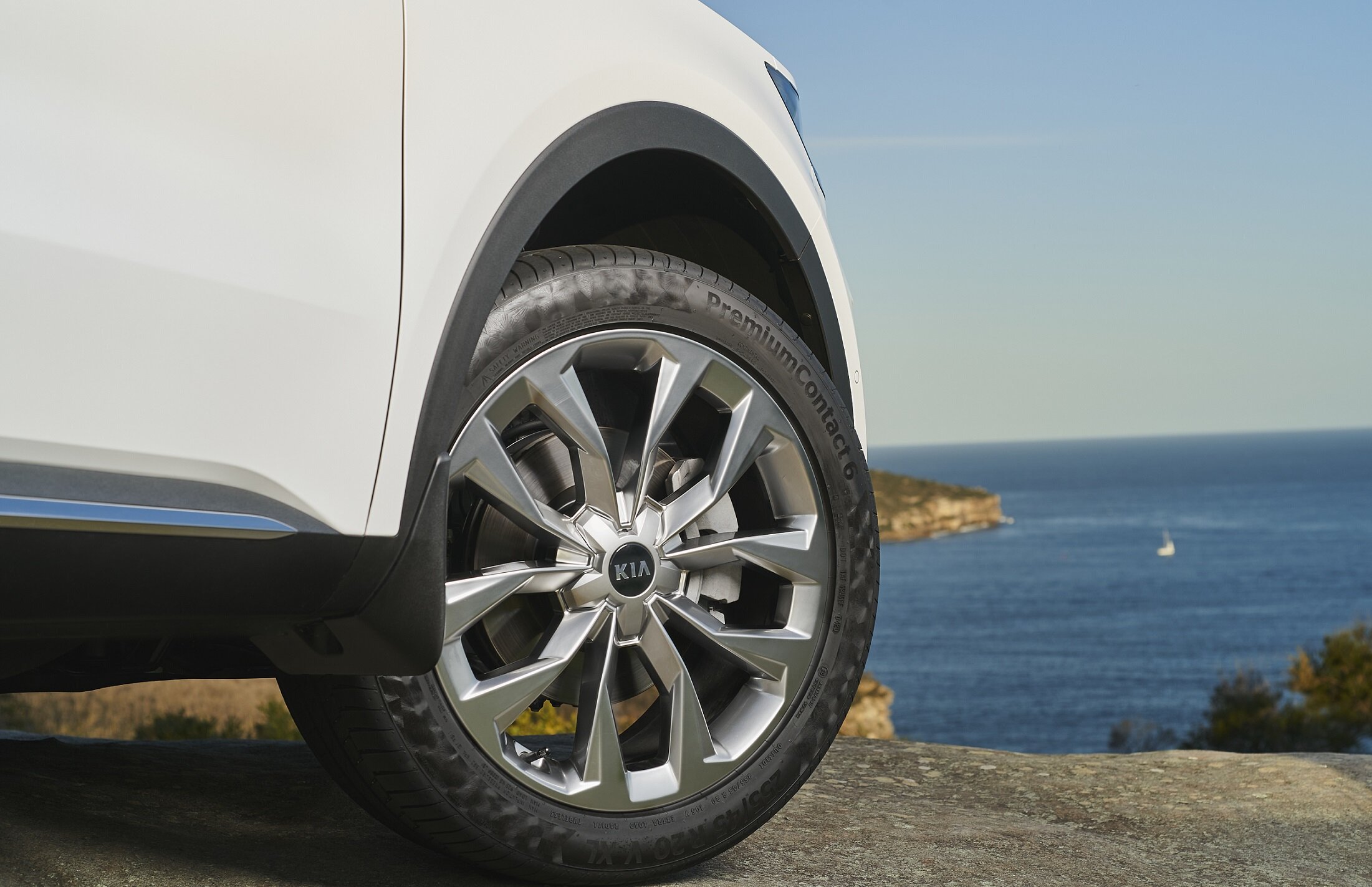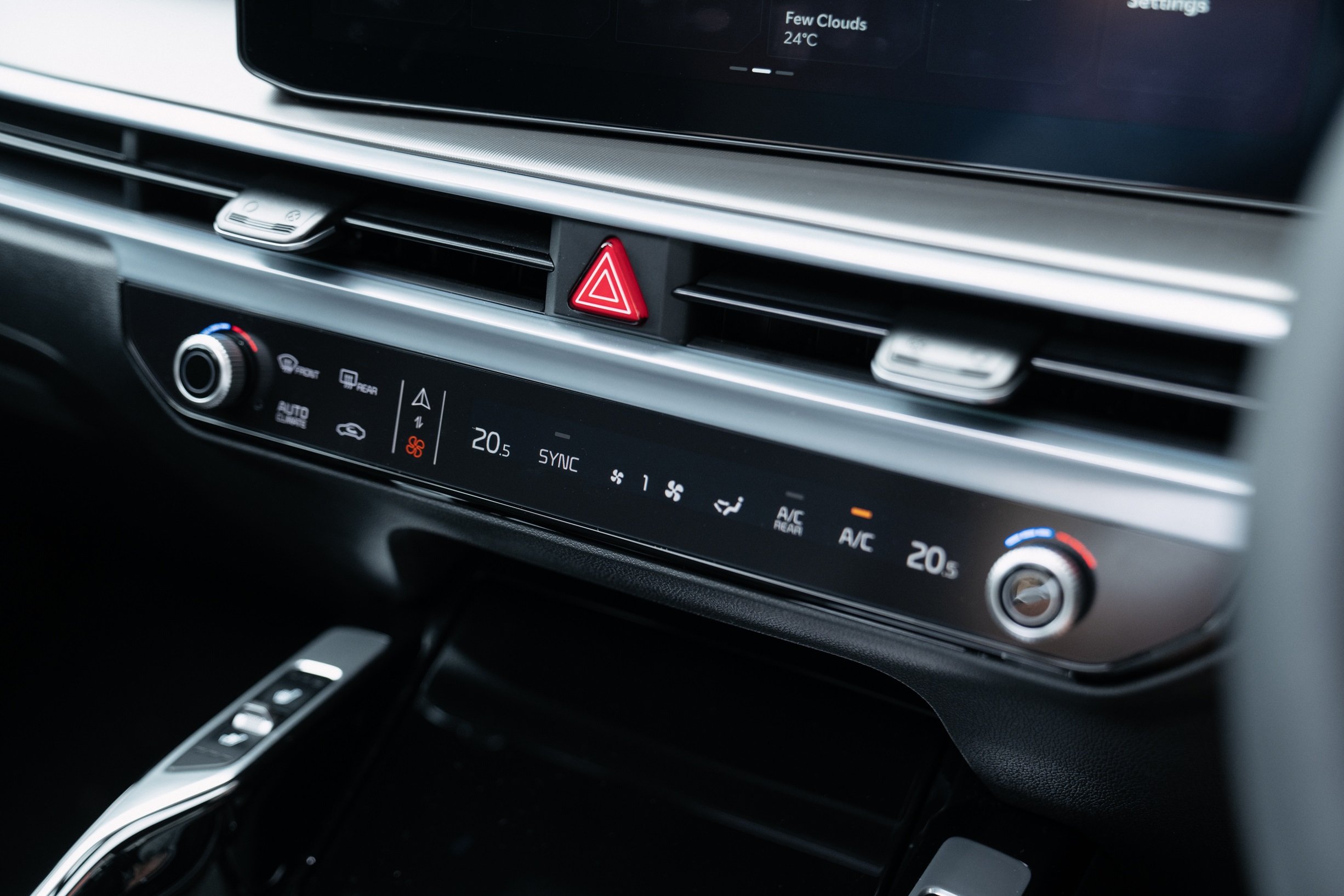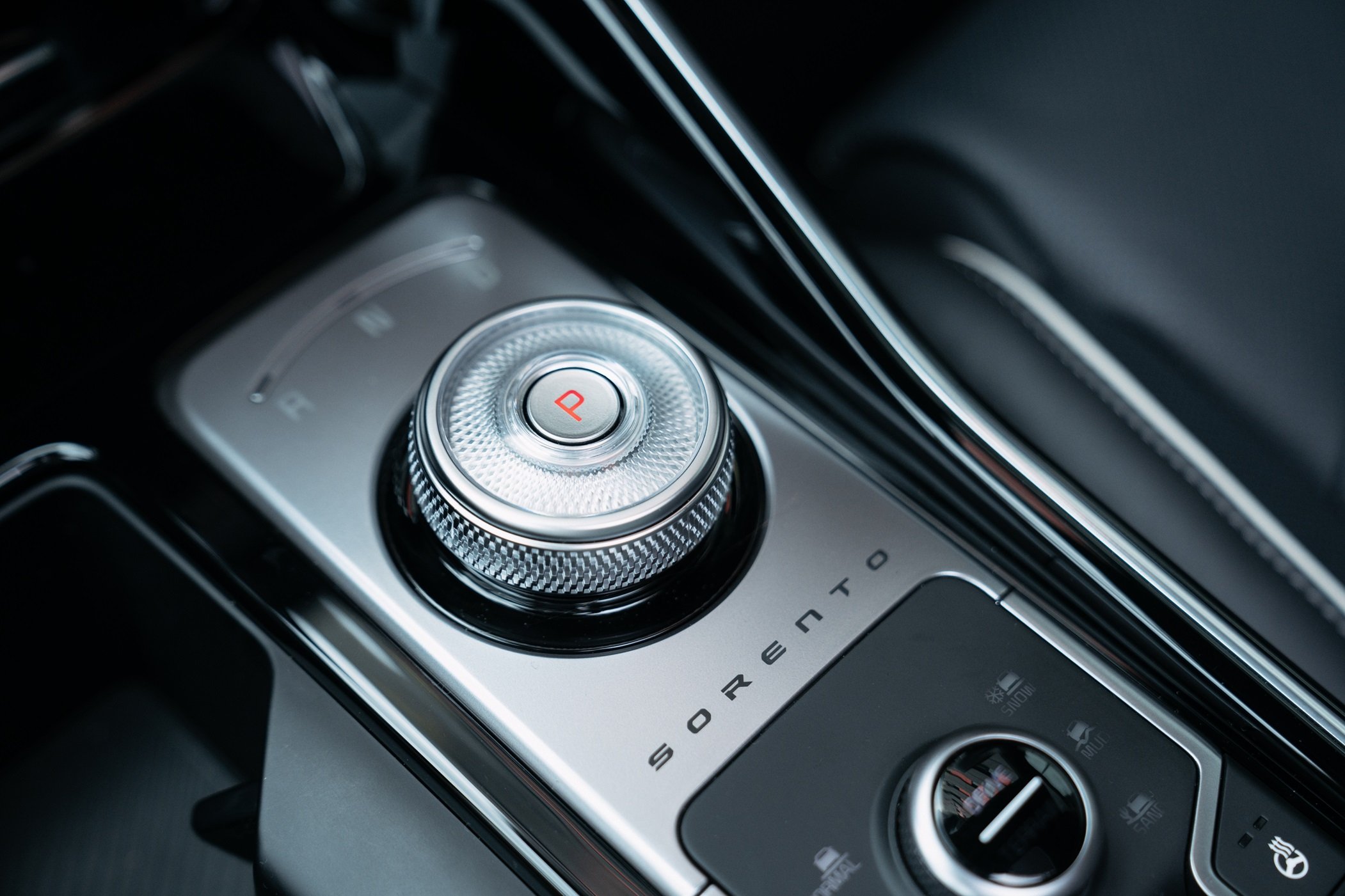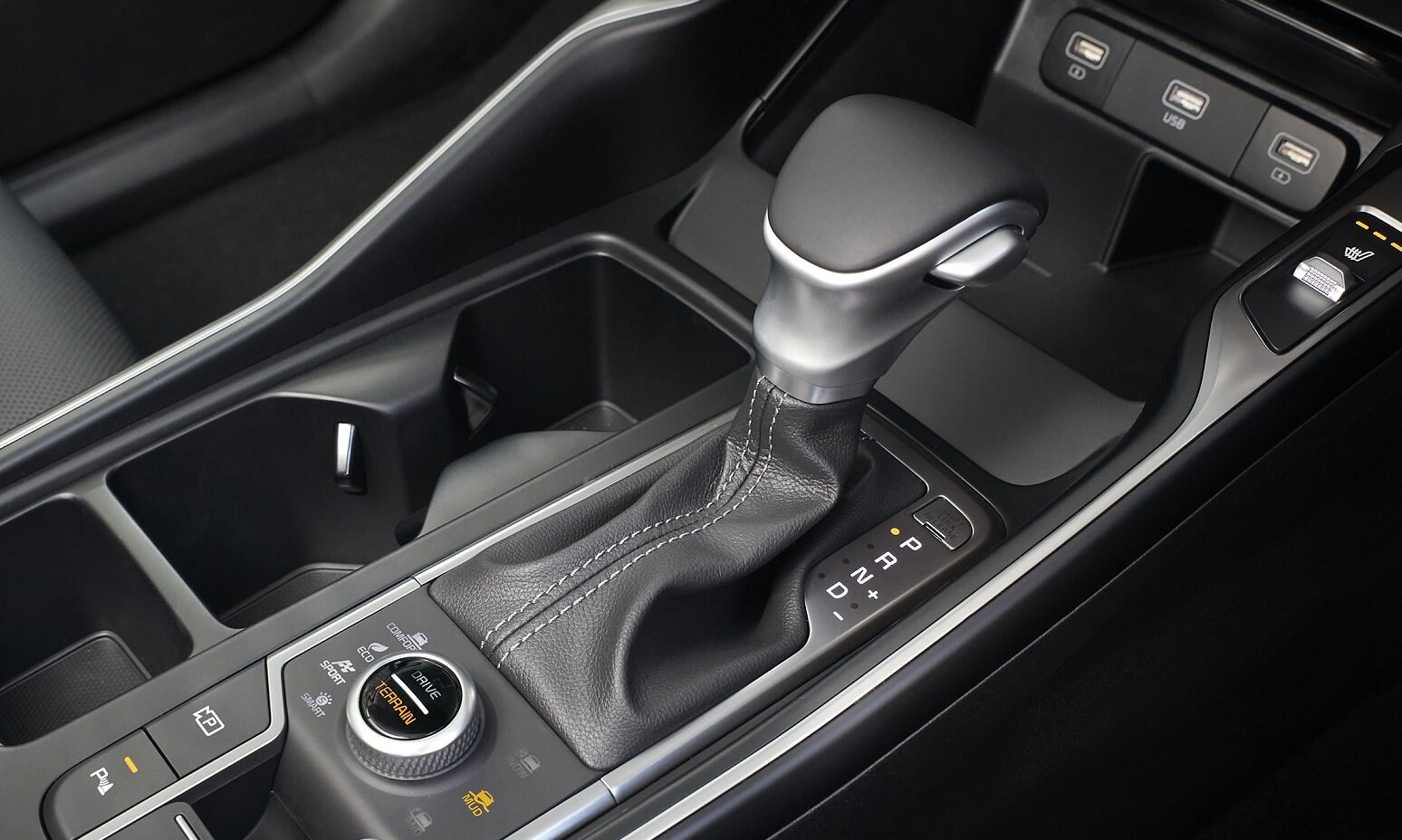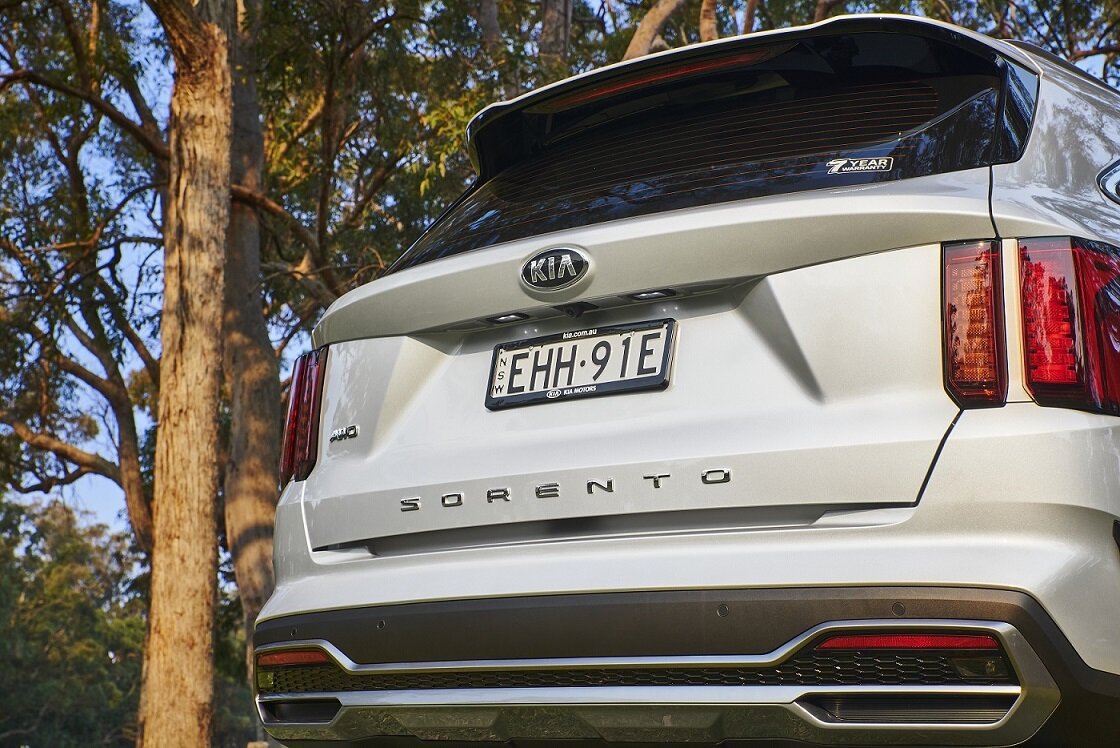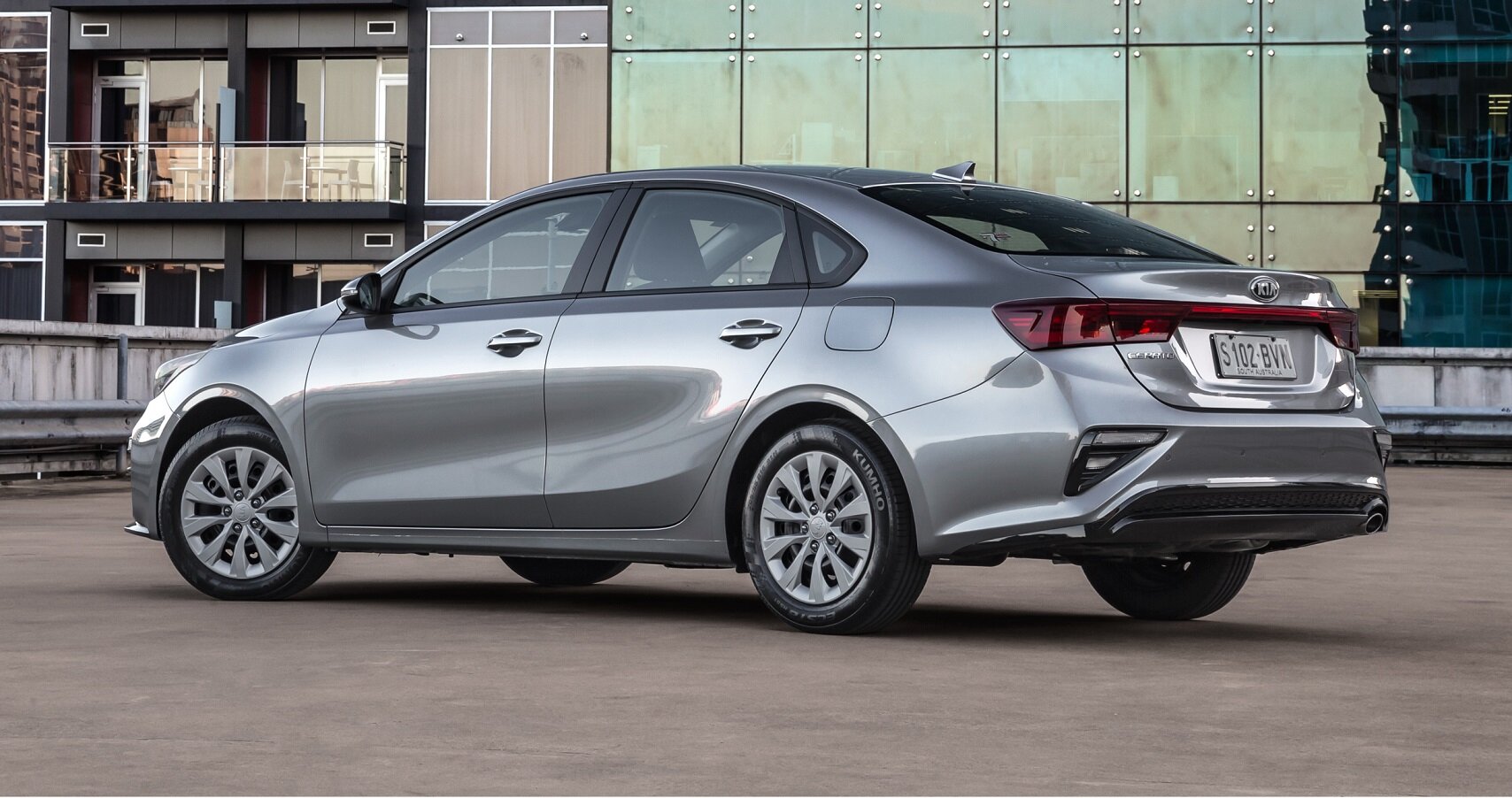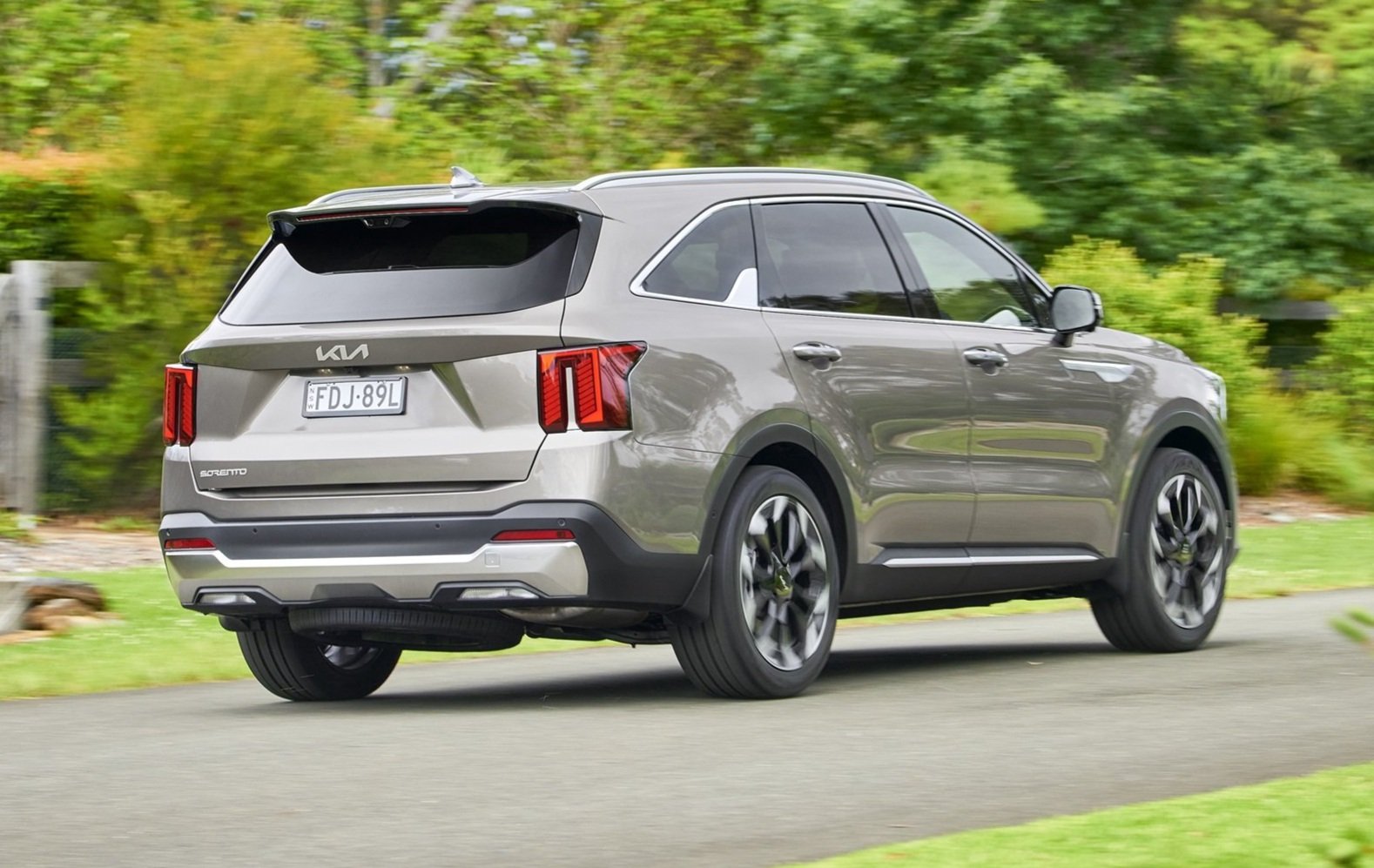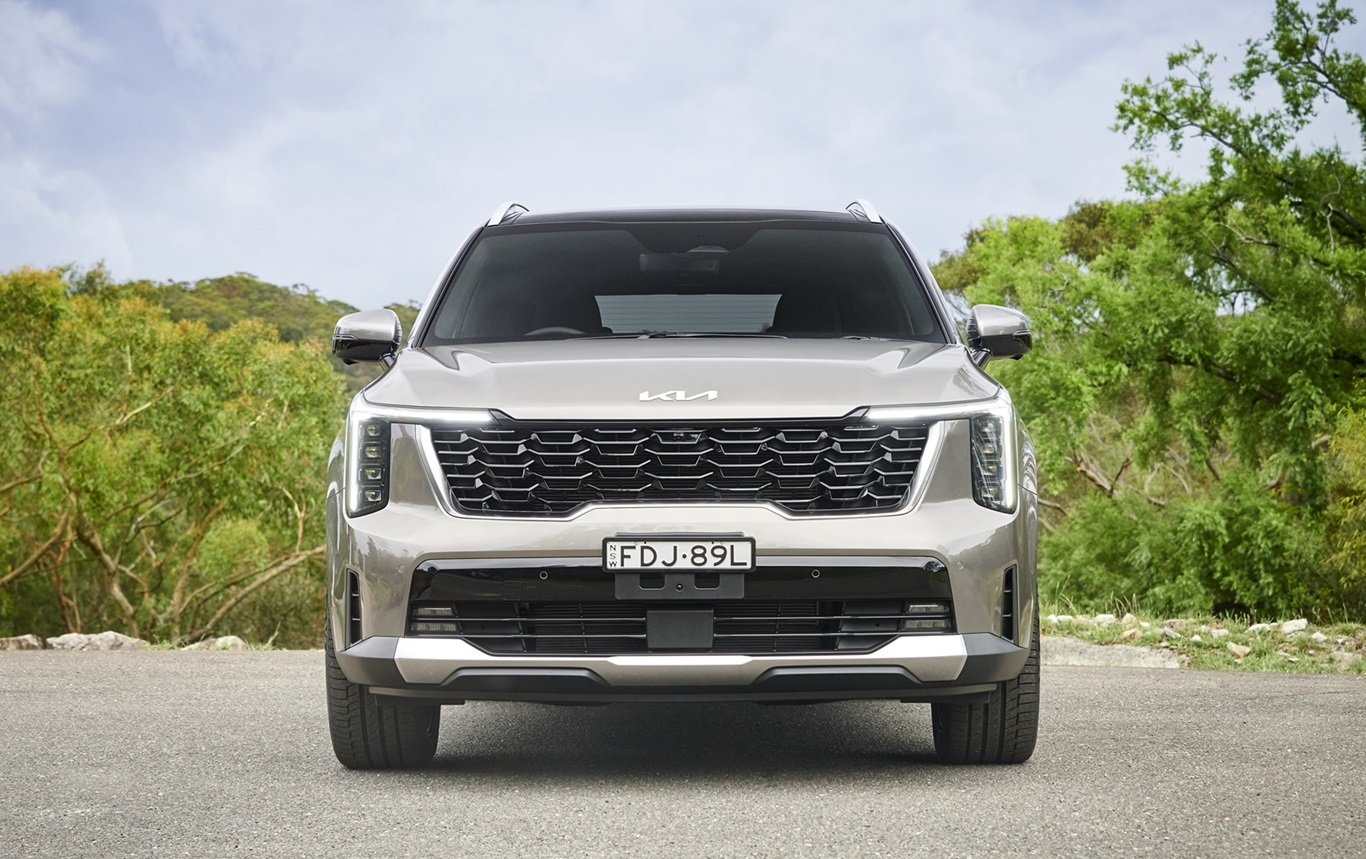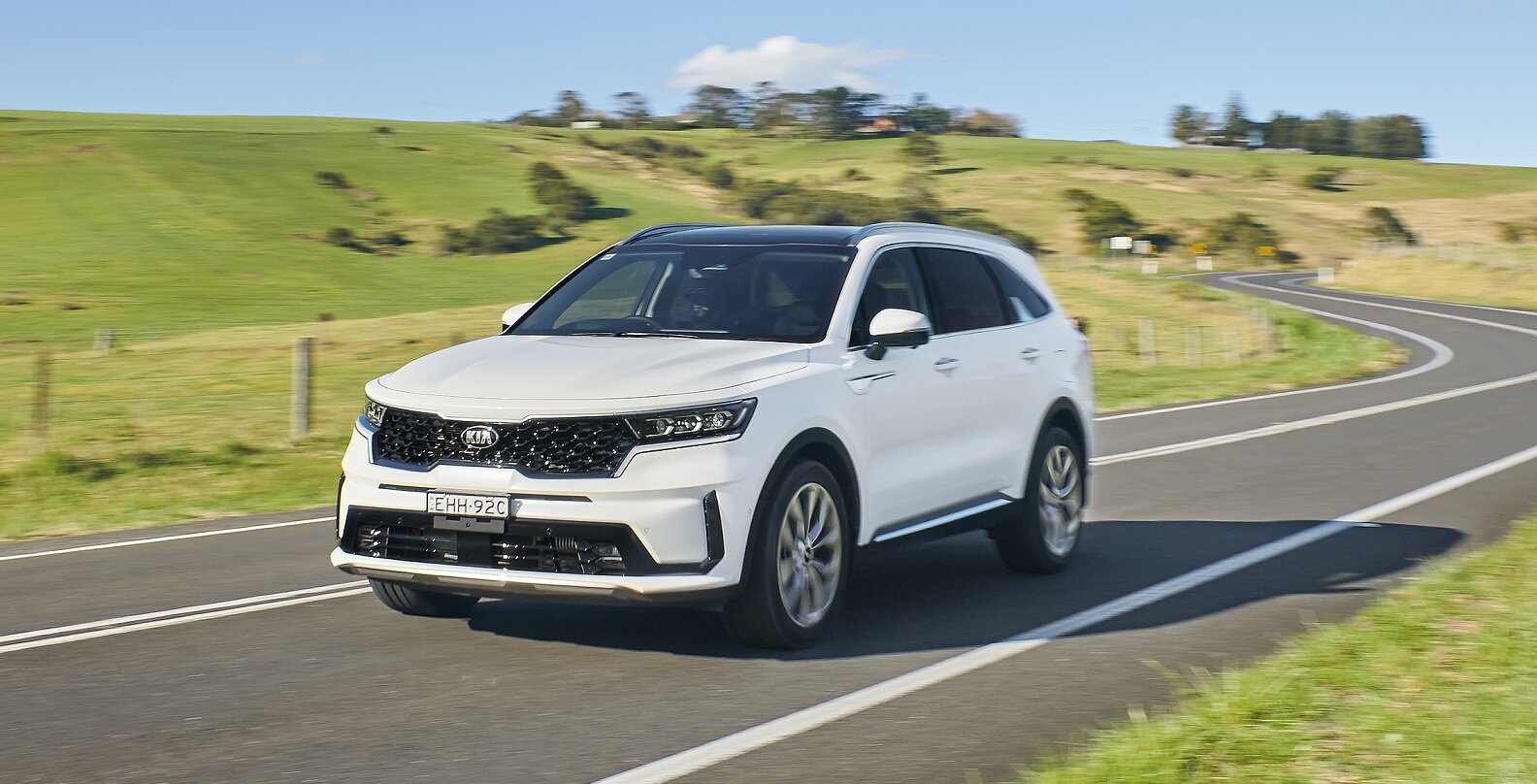Kia Sorento review and buyer's guide
The Kia Sorento is as close to a prestige SUV as you can get, only without the big price. You would pay thousands more for an equivalent Mercedes or BMW, but a new seven-seat Sorento will be far more reliable and better value.
The Kia Sorento is a smart choice for growing families who need a generous, luxurious cabin with plenty of modern features in a reliable, practical SUV.
Sorento has a powerful engine and transmission combination, excellent build quality and a beautifully designed, well-appointed, highly practical interior.
Sorento continues putting notionally prestige brands to shame, because it offers similar levels of refinement, with 7 seats, at a good price.
The reason Sorento can do this is because it uses a powertrain that has been proven dependable for many years, and offers next-level interior design that is as easy to use as it is pleasant to look at - without the need to be excessive or over-indulgent in the manner of a prestige brand.
This vehicle has been updated for 2024, but that doesn’t mean you’re getting an ‘old’ Sorento in new clothes here either. There’s new headlights, grilles and wheels, but also some new features and a widening of what available as standard. The latest ‘refresh’ for the range brings it into stark relief against some competitors like the Mazda CX-9 and Toyota Kluger - both of which look a bit dated beside Sorento.
You might also like to check out the Hyundai Santa Fe with loads of equipment in its middle-tier ‘Elite’ variant, or the Palisade 8-seater, which shares a skeleton with Sorento and Santa Fe. Palisade is a bit like a LandCruiser only without the 4WD ability, which you don’t need for taking kids to school during the week, footy on Saturdays and taking the family on touring holidays.
The Kia Sorento is one of the vehicles on the AutoExpert Buy Now list for 2024 >> because the Hyundai/Kia diesel engine could be about to disappear in the next Santa Fe >>.
The Sorento line-up is fairly straightforward and easy to understand. So let’s start with pricing and each model grade’s equipment specification, to see which one suits you and your budget.
There are two primary options for Sorento, either the budget-conscious petrol version which gets a V6 front-wheel drive combination, or the notionally ‘premium’ powertrain, the 2.2-litre diesel in all-wheel drive. However, the diesel is actually the best engine package on this vehicle offering the best fuel economy, for only a small increase in price (about $3000) over the petrol. Generally speaking, there is a good likelihood you will make back the difference in a typical year of driving.
There is going to be a hybrid arriving in showrooms, which uses a 2.5-litre 4-cylinder turbocharged petrol engine in combination with a fairly modest battery and motor combination which will mitigate emissions and those spikes in fuel consumption in stop-start commuter traffic.
Then there’s a plug-in hybrid Sorento also coming, which will use a bigger 14kWh battery as a best-of-both-worlds option for both busy traffic short trips where you can run on purely electric propulsion, and then switch to combustion for longer journeys potentially outside of frequent EV charging networks.
FEATURES & PRICING
Before we get started, you can download the official Kia Sorento specifications here >> There are four Sorento model grades priced before on-road costs below:
‘S’ - $50,700
‘Sport’ - $53,700
‘Sport+’ - $56,300
‘GT-Line’ - $65,600
Now, at each model grade you need to add about $3000 for the AWD-diesel powertrain, so a GT-Line diesel does top-out at $72,000 give or take a little, before adding on-road costs. That’s about $3000 more than it used to bed, but the caveat there is that Sorento is like every single other vehicle or retail product out there that has gone up in price in the last few years.
There’s a $15,600 gap between the ‘S’ base model and the range topping GT-Line, which is actually a smaller gap than the previous Sorento. That’s a bit rare these days.
So, how do you make sense of this and which one is the best value?
Well, generally the bottom of the range is there for accountants in corporate or government fleets who buy vehicles by the dozen. Or for those on a very tight budget. They strip out all the frivolous equipment to get the price low. But even a base model Sorento is surprisingly well-equipped and offers you a lot of potential.
If you don’t need all the frills and luxuries, but you want a fairly big vehicle for your growing kids who treat the car like a playground anyway, the S is insane value against upper echelon medium-sized SUVs. The S also has the highest payload, making it ideal for filing with heavy stuff if you live in the country and plan to use it as a miniature ute, or to tow with.
Sorento S
$54,000 d/away approx. | 3.5L V6 petrol (non-turbo) | 8spd auto | front-drive
$57,000 d/away approx. | 2.2L turbo-diesel 4-cyl | 8spd dual-clutch auto | all-wheel drive
you get:
Front & rear parking sensors with in-dash graphic, auto wipers
LED headlights, foglights and DRLs (daytime dunning light, auto high beam, dusk-sensing headlights
Auto emergency braking, lane-keeping, blindspot collision avoidance, safe exit warning
4 x ISOFix anchor points, 5 x top tether anchor points
DAB digital radio + 7-speaker stereo, 12.3-inch LCD infotainment screen
Wireless Apple CarPlay & AndroidAuto, Bluetooth, 2 x front USB charging, 1 x 12-volt power outlet (row 2)
Paddleshifters, rotary transmission selector dial, acoustic windscreen treatment
17-inch wheels, full-size spare wheel, cloth seats, manual seat position adjustment
So on a tight budget, for only $3000 more, you’re buying for yourself the Sport.
Sorento Sport
$57,000 d/away approx. | 3.5L V6 petrol (non-turbo) | 8spd auto | front-drive
$60,000 d/away approx. | 2.2L turbo-diesel 4-cyl | 8spd dual-clutch auto | all-wheel drive
adds:
GPS satnav (incl. 10 years map updates), tyre pressure monitoring, 18-inch wheels (full-size spare)
10-way electric driver's seat (incl. lumbar), rear privacy glass, dual front extendable sunvisors, auto-dimming rearview mirror
Dual-zone climate control, auto defog, row 3 A/C vents & fan controls
The smart choice on value is another $3600 for the Sport+.
Sport+
$62,000 d/away approx. | 3.5L V6 petrol (non-turbo) | 8spd auto | front-drive
$65,000 d/away approx. | 2.2L turbo-diesel 4-cyl | 8spd dual-clutch auto | all-wheel drive
adds:
Proximity key with push-button start, power tailgate, remote start, row 2 retractable window shades
Leather heated seats (front), heated steering wheel, USB charging in row 3, 2 x high-mounted USB charging row 2
heated door mirrors, electric tailgate (with auto opening), external ambient door handle lighting, rear LED taillights
BOSE premium 12-speaker sound system (incl. subwoofer)
19-inch alloys (full size spare)
The works burger costs you about $7700 more than Sport+, which is a considerable jump, but as time has gone on, Kia has actually reduced that price difference in 2025. But it’s jam-packed.
GT-Line
$69,700 d/away approx. | 3.5L V6 petrol (non-turbo) | 8spd auto | front-drive
$72,700 d/away approx. | 2.2L turbo-diesel 4-cyl | 8spd dual-clutch auto | all-wheel drive
has also got:
12.3-inch digital driver’s dash cluster (2 x 12.3-inch screens), remote parking, 360 camera
20-inch alloy wheels (full size spare), wireless phone charging, posh LED ‘ice cube’ headlights
Nappa leather + suede black headlining, heated 2nd row outboard seats, ventilated (cooled) front seats
Cabin intercom, electric child lock, cargo net, LED interior lighting, alloy sports pedals, multi-colour interior mood lighting
Panoramic sunroof, auto-dipping door mirrors (reverse), driver’s seat position memory + 14-way electric seat adjustment
Safe exit assist (automatically locks doors upon traffic approaching), reverse collision avoidance, blindspot camera
This stuff is all nice, of course, if you’ve got the cash, but can you live without it and settle for a Sport+? Yeah, absolutely.
INTERIOR
Sorento’s base model is called ‘S’, its second-tier model grade is the ‘Sport’, and the third-tier ‘Sport+’ variant is generally the best value.
All of these three grades now get a small 4-inch driver’s instrument panel to replace analogue gauges, while also replacing Hyundai/Kia’s need to source those individual parts when screens are cheaper these days. How times have changed.
The good thing is Hyundai and Kia are smart enough to let you drive with your low-beam headlights on without defaulting the car into night-mode which dims the brightness of those screens. Case in point: heavy storms, fog and snow, or just dense spray from wet roads where DRLs are insufficient to make you stand-out in traffic.
The headlights, foglights and daytime running lights are all newly shaped, which you can see with your own eyes, but what you might not notice is the transmission selector. Or more specifically, the lack of transmission selector. That’s because it’s gone completely. Yes, Kia has made its sleek ‘shift-by-wire’ rotary transmission selector standard across all model grades.
This means you no longer have to contend with it when using your charging cable with your phone, particularly in the lower variants where wireless phone charging is unavailable. This lack of shifter also means you don’t have to worry about shoving it into ‘Park’ and crushing your phone if it pokes out the top of the centre cubby hole.
The Bose 12-speaker boombox and amp are now available on Sport+, and there are two new colours.
Unfortunately, it’s not all good news, potentially. In its attempts to stay sweet with the wayward, hypocritical ANCAP safety rating buffoonery, Kia has also been forced to shove ‘Highway Driving Assist’ upon buyers of all spec-levels from Sport to GT-Line. This so-called advanced safety feature centres the Sorento within the lane on a motorway, which you may not necessarily want it to do. This isn’t Kia’s fault, it’s because when it comes to safety ANCAP has lost the plot on ADAS >>
Having said that, Kia and Hyundai have developed their systems to be easy to turn off, via a button on the steering wheel, if you don’t find them helpful, or if you simply find them intrusive.
You can see clearly new wheels, a slightly revised interior, and the GT-Line will beep at you a bit more if you’re about to clobber something on either side when parking, thanks to ‘Parking Distance Warning’ which adds side detection zones to the front and rear.
Also on GT-Line is a pair of 12.3-inch panoramic touchscreens, plus a digital centre mirror that allows you to swap the conventional rearview mirror to use the rear widescreen camera instead for a bigger picture. This is quite good for seeing into that rear blind spot behind the tailgate and the rear-quarter section.
The first thing you’ll notice when you get into Sorento for the very first time is that pretty much everything feels premium. Then you’ll try to give yourself context about why it’s such excellent value, because the price is less than $75K, from a carmaker with first-rate support credentials
The seats alone are big enough, comfy enough and supportive enough without being on the compromised end of that description where firmness and the word ‘bucket’ start getting used. They are going to be more than satisfactory on a long holiday roadtip or simply sitting in peak-hour.
Even the rear seats get something resembling the Midas touch here. They’re bolstered quite well, without becoming too bulky to fold flat when you drop the seatback. Legroom is very good considering this is the same 2.81-metre wheelbase as the previous iteration. The interior feels tailored, somehow.
If however, you have a particularly tall family, you should have a think about the Kia Carnival >> and the Hyundai Palisade >>. Both are longer in wheelbase (which translates into legroom), they’re both taller (good for headroom) and the general ease of getting into and out-of those vehicles is much better in the context of three or more kids, possible child restraints and plenty of big cargo like eskis, luggage, tents and various bulky stuff.
Test drive one
So, when you test drive this vehicle (which should be done separately to buying it), get the sales person to show you how to use the primary tech features you want to use. Play with the radio, connect your phone, adjusting the air-con and figure out how all three rows of seats function.
But you also need to know how and to what extent the unwanted things can be turned off. You’ll want to know how to:
turn off the ‘Sounds of Nature’ ambient sound;
Turn GPS satnav instructions off;
Cancel the lane keeping vibrations and warning tones,
And if you need to ask the sales guy to not help with the tech, and let you see if you can figure it out, do so; or do get him to help if you need it,
On a sidenote, it’s your test drive, so don’t be scared to ask for silence on the drive either.
Turn everything off, because then the Sorento becomes a far more premium driving experience. Trust me on this, or just try it both ways.
And do plug your smartphone in, via USB. Do this for two reasons:
First, make sure that the car and your phone are truly on speaking terms. Get your music going, invoke the voice control, phone a friend - do it all. This is an increasingly critical part of using the car, right? Do not pay a deposit, sign a contract, take delivery, and then discover these two devices are hard to do easily (for you).
The second reason for doing this is: all carmaker infotainment OS is clunky, generally speaking. But the screen on the Sorento is really nice, with slick graphics, and the designers have done a decent job simplifying all that complexity - however imperfect it remains. All carmakers struggle at perfecting this, not just Kia, and not just Sorento.
Subaru’s big portrait touchscreen which debuted in the Outback had no specific buttons for adjusting the AC fan speed, recirculation or where you wanted it (face, feet, windscreen). They only had temperature. So they fixed this by adding a permanent set of controls at the bottom of the screen. This is an improvement, sure. But if the screen fails, you’re still stuffed if you need to defog on a frosty morning, or crank the cooling on a hot day with kids in the back.
The one issue with screens, and Kia’s touchpad interface for the HVAC controls is glare, which can reflect off that shiny surface and partly obscure the iconography or the text labelling the function you want.
What’s a nice thing to see on Sorento is the healthy level of remaining buttons and switches despite the industry’s obsession with going everything-touchscreen. The fact is buttons require the bare minimum cognitive input from you, the driver, to use them in the added context of driving the vehicle itself.
The workload demands in Sorento remain pleasantly low in the face of relentless demand to make everything a touchscreen button crammed into a submenu which requires you to take your attention away from the road. The reason this happens is because buttons have what’s called ‘haptic feedback’, meaning your brain registers a response via your finger when you touch a button, because it moves and depresses when you apply pressure.
Touchscreens don’t do this, so your eyes have to locate the icon in space, your brain has to perfectly direct your finger onto the spot, and then when you press it the icon, you don’t actually know you’ve pressed it until there’s some change in the radio/cooling/a blip from the system or whatever. But sometimes screens are glitchy and they often don’t register unless you hit the icon perfectly dead-centre - which can be hard to do while navigating traffic and your kids are demanding your attention.
Buttons are superior because they work, for us, as humans. We’re all fallible creatures and that’s how we learn how to do things: we touch things with our index finger, then hold it with our opposable thumbs.
Full points to Kia (and Hyundai while we’re at it) for not completely abandoning buttons. Okay, fine, you too Subaru.
ENGINE
The diesel is a 2.2-litre turbo, an evolution of its predecessor and it’s the best powertrain in the Sorento range. Not just because it’s the notionally ‘premium’ engine, but because it’s so well matched to this vehicle overall and what you’re likely to do with it.
It’s got an aluminium block, which shaved almost 20 kilos off the bathroom scales (compared with the older version), and (together with the transmission) delivers excellent fuel economy - 6.1 litres per 100km on the official combined cycle test, and 5.3 on the highway.
You really should consider the diesel, but if you’re on a very tight budget, there’s a petrol V6 in the range as well, which is front-wheel drive only. No all-wheel drive with the V6 petrol engine.
You should also be aware right from the start that dinosaur V6 petrol engine consumes about 30 per cent more fuel than the diesel. It’s an old powertrain. And that’s being conservative about that percentage.
The $3000 or so extra you’ll spend getting the diesel would buy you about 22 tanks of petrol, that’s true. But if you (conservatively estimating here) fill up once a fortnight, that’s less than two years before you break even and start saving money. (You’ll likely fill up more frequently than that, meaning the following savings will come forward in time much sooner depending on how much driving you do.)
Now, initially that might not sound compelling, but think about it. You’re going to have this vehicle for how many years? At least three, definitely five, and potentially more than seven years. If you own your Sorento for the next 10 years, you’ll have saved approximately $12,000 by spending a little bit more to get the diesel - potentially.
So the diesel is paired with AWD which is a winning combination for two reasons. 1) the vast majority of Sorento buyers get the diesel engine, meaning it will have lots of parts available; and 2) this will be great at re-sale time five or 10 years down the track. It’ll be much easier to sell because it’s more desirable in the used market.
If you’re an average sort of driver looking for a versatile SUV with five seats and a large cargo bay, or seven seats and modest cargo capacity, then Sorento V6 is a definite starter. You can probably live with the V6 and the front-drive configuration, and you’ll save a few bucks.
The diesel is definitely better because it’s smoother and more composed thanks in part to the all-wheel-drive powertrain, and also because the diesel just makes more mid- and low-rpm power. It’s also a lot more fuel efficient, because diesel is more energy dense than petrol. It also emits less CO2 if that’s a concern for you.
On the subject of adventuring, Sorento diesel AWD is compatible with dirt roads and easy fire trails and driving of that nature - but if you throw properly difficult terrain its way, you’ll probably break something. It’s just not designed for that.
All-wheel drive is a real plus for family camping. Like, if it rains overnight and the dirt road you drove in on turns to mush, you stand a far better chance of fronting up for work Monday morning, with AWD. If that’s you, buy the diesel.
The all-wheel drive and diesel engine combination is also great if you plant to do some kind of towing, perhaps with a camper trailer or some kind of moderate trailer with some bikes, kayaks or the odd bit of gravel or soil. But it’s not a hardcore 4X4, so take it easy. (More on towing below)
There’s a brilliant transmission with the diesel Sorento as well.
A hybrid 1.6 turbo-petrol powertrain is coming to the Sorento, most probably in 2025 - so watch out for that. And don’t be surprised if the 3.5 V6 becomes unavailable very soon.
Another alternative powertrain change coming for Sorento might be the 2.5-litre turbo-petrol unit we’ve seen introduced in the new Hyundai Santa Fe. Given that the current Sorento is riding on the same platform as the 2020 model, which is a distinctly different platform from what the Hyundai Santa Fe is, we might see a wholly new Sorento arrive in 2026 or 2027 with these same hybrid and 2.5 petrol powertrains as the Santa Fe.
This is because Sorento and Santa Fe have, historically, been effectively the same skeleton underneath (chassis, suspension, steering and powertrains) as each other (because Kia and Hyundai jointly develop their models, if you weren’t already aware).
TRANSMISSION
Having torture tested this eight-speed dual-clutch transmission several years ago, it was quite apparent then as it is now that some serious research and development went into making this transmission completely at home with hard work.
The Sorento’s transmission also proved itself very smooth and robust indeed when applying an extremely light throttle pressure to get going from stationary. This is the harshest thing you can do to a dual-clutch. It’s also something you should avoid when driving your DCT in heavy stop-start traffic; don’t creep forward, just stop or go.
But it does cope very well on a steep hill where, the load on the transmission increases significantly compared with flat roads. You’ll actually struggle to pick the point at which the automated clutch engages and you have full drive forward. That’s the sincerest compliment to the bunch of engineers working on the development of this dual-clutch transmission.
As far as engaging drive goes, it’s now as easy as flicking a switch. A rotary switch, that is.
This is the default transmission selector on all model grades of Sorento, regardless of whether you have the AWD-diesel or FWD-petrol. It couldn’t be easier to use and in fact, it’s also intuitive: flick right to engage ‘Drive’; flick left to engage ‘Reverse’. Push the centre button for ‘Park’.
The best part about using the rotary dial is when you’re doing a hairpin turn and need a quick change of direction to realign the front. Three-point turns, very slickly done with two flicks of the dial.
DCTs are fantastic at lightening fast upshifts and downshifts - that’s what they’re good at. After a week driving it, it’s very hard to confuse it, it’s extremely refined off the mark, and I would suggest 95 per cent of ordinary owners who drive it will just think it’s a conventional automatic. And that’s the nicest thing you can ever say to said engineers.
(But just for disambiguation, try not to drive it entirely like a conventional auto by creeping in traffic. Be nice to the clutch regardless of how brilliant it is.)
I'll help you save thousands on a new Kia Sorento here
Just fill in this form.
No more car dealership rip-offs.
Greater transparency.
Less stress.
FUNCTIONALITY
There’s plenty to like about how the Sorento’s boot space works when you have two kids, but particularly is you have a brood more like four. And it starts with the tailgate design.
With all rear seats dropped, you’ll get 1996 litres of luggage space, which reduces to 608 litre with row 2 up, and then 179 litres when you engage row 3 seats.
Here’s what that looks like in practice:
There’s four ISOFix anchor point pairs in a Sorento, making it a very good multi-purpose family vehicle for anybody with twin and one or two already alive and kicking. Having a 5+2 seating configuration works especially well when you have unexpected additional family members joining you after school or on weekends.
What’s smart about the Sorento’s boot is the straight line you can draw between the lower section of the aperture wall and the wheelarches. This means you can load long, straight and heavy things in a linear, efficient manner without the need to reangle some stroller or pram to make sure it avoids either the wheelarch itself or the inner bulkhead.
There’s a low boot lip edge to stop wheeled bags from trying to Frogman itself into the mud the moment you open the tailgate. and when you’re dropping the rear seats, row 3 is as easy as ONE tug of the relevant release strap - which double as your retrieval tether when you need to redeploy.
When it comes to row 2, you can do it either manually using the release handle/button (depending on which model grade you get) on the actual seat itself if you have the doors open. Or you can us the electric release buttons on each side of the boot wall.
TOWING
There is a particular harshness to driving the Sorento over very small bumps, such as expansion joints in highway bridges or joins in two separate patches of road. It’s a jarring that comes through where it hasn’t on previous Sorentos. I think this is because of the engineering trade-off in developing a new suspension package, while keeping the towing limit at two tonnes.
What happened with Kia Sorento’s towing capacity? Click here for my full diagnosis >>
But Kia was touting 2.5 tonnes earlier in the year, so I asked them what happened to the missing 500kg. Was it something to do with the new dual-clutch, was it the suspension, or was it the platform?
After a protracted conversation, Kia has told me it’s a consequence of the towbar design. Here’s what that means: Kia has a protocol for endurance testing, and without them giving the game away to the competition, they do 100,000 cycles with the towbar design and they were only robustly confident the towbar could meet that safety benchmark with two tonnes.
This vehicle weighs about two tonnes. Trailers towed routinely in Australia are dynamically unstable in yaw and pitch, which is why I always say it’s a bad idea to tow a trailer weighing more than the vehicle, lest you become a compound pendulum and come off the road. Two tonnes in Sorento is pretty rational.
If you want the numbers on that, I’ve done a far more detailed report on towing with the new Sorento. Let’s just say if you load up with a 2000kg trailer that delivers 200kgs on the towball, once you crunch the numbers on towing like that, there’s around 425 kilos of payload capacity remaining in the vehicle.
So all of the people inside, including you as the driver, and all of their stuff, any luggage and all the accessories you might fit … not to exceed 425 kilos. I’ve made an allowance for the towbar in that number (because you can’t tow without it, obviously).
Bottom line: So you’d want to be real careful about towing 2000kg with all seven seats occupied, or even a family of four aboard, with some gear. It’s do-able, but there’s not a lot of wriggle room.
If you are looking for that heavier towing capacity at 2.5 tonnes, I’d suggest you wait and see what happens with the new Hyundai Santa Fe which could come with a different towbar design and might offer you that extra margin you’re looking for without having to move up a rung and get something more hardcore like the Mitsubishi Pajero Sport.
You’ll also find a full-size spare wheel mounted externally under the boot, on every combustion variant of Sorento. We'll have to wait for the PHEV and hybrids to arrive to confirm, but it’s highly likely they will also get the full-sizer considering the previous versions did.
MAIN COMPETITORS
If you’re shopping for a large 7-seat SUV then you simply need to look at the Mazda CX-9, the Hyundai Santa Fe, Toyota Kluger, but it’s also worth keeping a Kia Carnival in mind, as well as the Hyundai Palisade, if you need frequent third-row use with easy access. If the 7-seat aspect is more of an occasional use only deal, and if budget is somewhat constricting, you could also consider the Mitsubishi Outlander for more of a 5+2 usage case.
Mazda CX-9
Pro: Row 3 curtain airbags, luxurious interior on top-half model grades, rotary infotainment screen selector dial, powerful 2.5-litre turbo-petrol engine standard, conventional epicyclic auto transmission, decent moderate towing capacity;
Con: space-saver spare wheel
Click here for more on Mazda CX-9 >>
Kia Carnival
Pro: 7-seats (4 x ISOFix) ,sliding row 2 door make carpark access easy, detachable middle row centre seat means walk-through row-3 entry, decent moderate towing capacity, economical and grunty diesel engine for big family trips, looks like an SUV;
Con: space-saver spare wheel
Click here for more on Kia Carnival >>
Hyundai Santa Fe
Pro: full-size spare, 7 seats, high equipment levels in Elite & Highlander, reliable diesel-AWD powertrain, decent moderate towing capacity;
Con: No row 3 ISOFix points, no row 3 full-coverage curtain airbags
Click here for more on Hyundai Santa Fe >>
Nissan Patrol
Pro: Hardcore low-range 4X4 with all-terrain off-road capability, tows 3.5 tonnes,
Con: Nissan wants $100K for the Patrol now, $20K more than Palisade. So do you actually intend to take your Patrol off-road, into low-range and across the Great Dividing Range, or just drive around in the suburbs?
Click here for more on Nissan Patrol >>
Toyota Kluger
Good: Hybrid powertrain for stop-start city driving; good combined fuel economy 5.6 L/100km, full-size spare, 18-inch wheels, row 3 curtain airbags, warranty 5yr/unlimited km, equipment: front & rear camera, driver knee airbag, all-LED lights, auto wipers, dual-zone climate, satnav
CON: Short service interval 6mth/10,000km (whichever first), demands premium 95 RON fuel (could offset fuel economy saving), cloth seats, heavy at 2050kg (kerb wt.) | Santa Fe Elite (D): 1943kg | CX-9 Azami LE (AWD) 2011kg |
Expensive, no diesel engine for towing, long delivery wait times, base paint colour is black - the worst for keeping clean; white/colour adds $700. For more on Toyota Kluger click here >>
Hyundai Palisade
Pro: Huge boot space and payload to rival Toyota LandCruiser, full-size spare mounted externally at rear (no unloading the boot to access), active AWD system paired with grunty 2.2 turbo-diesel, good row 3 access, loads of standard equipment and properly premium interior, excellent legroom and headroom for tall families.
Con: A bit light on towing, parking brake located on right-hand side of dashboard.
Click here for more on Hyundai Palisade >>
Sorento is pretty good and Kia’s products absolutely stand tall on their merits - in fact, they have done for years now. Kia is a top 10 brand now, often beating big sister Hyundai in the sales heats.
The equivalent notionally-premium German large is going to cost twice as much. Obviously they’re not exactly the same thing, and you definitely feel the premium aspect when you get into a six-figure Merc, but that’s an intangible, subjective analysis. When you look at features, reliability, quality and polish, the Sorento has the edge.
A fully-loaded Sorento GT-Line is about $70,000 drive-away, and it is properly premium. But it’s still a lot of money to pay in the domain of ‘mainstream’ brands. And some people will say ‘a lot of money to pay - for a Kia’. (Even though they’re the number six brand in the market by sales.) So, here’s a comparison for you:
A three-pronged Mercedes GLE base model shitter (I don’t think they call it that) is about $115,000, drive-away. And it’s got the badge, but it is pretty ‘poverty’ when you sit inside.
In fact, to get the peasant’s GLE up to roughly the same spec as a Sorento GT-Line you need to add the Seven-seat Package, and the Comfort Package for the heated and cooled seats. Plus real leather, because only fake leather is standard.
You’ll also need the Vision Package for the wireless charging pad and the sunroof. And the premium sound system. That’s a total of $15,500 in extras, bringing the roughly equivalent Mercedes GLE up to $130,000.
So, it’s two Sorento GT-Lines or one heavily optioned Poverty GLE. To be fair, the GLE makes 14 per cent more power across most of the rev range, albeit from a smaller engine. It doesn’t go any better, however, because it’s substantially heavier. Power-to-weight of both vehicles is identical … until you add all the factory options you need for rough equivalence to the GLE. Then the Kia is gunna go better.
Tow capacity is 2.7 tonnes on the GLE (versus 2000 on the Sorento). But the Sorento carries a heap more payload when it’s loaded to its maximum towing capacity. Sorento also has a full-sized spare, which the Benz does not, and the Sorento is 12 per cent more fuel efficient (mainly by virtue of being 400 kilos lighter, but the DCT also helps).
They used a lot of advanced high-strength steel in the new Sorento architecture, which allows them to cut kilos. Some of the critical bits are even hot stamped. Sorento is also slightly more compact. [Indicate 4”] About that much shorter.
But there is that (so-called) “legendary German build quality to consider”. Or, there would be, except of course the Mercedes GLE is made in the USA. So there’s that. And two more years of warranty with the Kia, of course, plus a far better customer support culture at Kia - customer service polar opposites there with Mercedes.
Objective conclusion: The poverty GLE is a confidence trick. Get you into the dealership on the expectation of paying just over $100,000. Then you get hit by that options bus (and Luxury Car Tax of course), and it’s all over. Don’t hesitate to burn me with hate in the comments if you are a Mercedes-Benz apologist/fan-boy. (I assure you: I can take it.)
I’m not saying these SUVs are the same thing. Not at all. I’m saying you would have to be flat-out brand-snob insane to buy the bottomless money pit we know and love as mainstream Mercedes-Benz. It’s different at the top of the range. If you want an SLS, knock yourself out. They’re awesome.
SIZING UP SORENTO
You might be wondering if the Sorento is too big. I’d suggest, no it’s really not. Too much is made of the difference in relative sizes of vehicles.
Sorento is in fact not all that much bigger than its pint-size cousin, the Cerato. Cerato is 4.51m long versus Sorento at 4.81m long, and the notionally small car is just 1.8m wide against the Sorento which is 1.9m wide. That’s a difference of just 30cm nose-to-tail and 10cm side-to-side.
And as for height, it’s the biggest difference but the more irrelevant to overall practicality, but there’s 1.7m of Sorento including the roof rails - that’s just 34cm taller than Cerato. But it’s all benefit for you if you’re considering buying the SUV because, in the real world, you can fit in all the same alleys and carparks as a Cerato.
DRAWBACKS
Now, this is the part where my praise of the Sorento is absolutely genuine, and it’s also where you, the consumer, can rest assured I’m not leading you on here, because it’s time for the negatives. You know this review’s not paid for because: brace for impact, Kia dudes; your Sorento is not perfect.
New Sorento styling trajectory is somewhat…arachnoidian in nature
If you’re the kind of driver who enjoys that Lexus-like detachment from the driving process, you’ll probably find the ride quality on the Sorento somewhat harsher than you prefer.
It doesn’t exactly crash over bumps, but it’s the tautest-riding new Kia I’ve driven for some time. Personally, I kinda like it, at times, but I’m merely flagging this for you if you prefer that limo-like detachment.
STYLING: If you like machines to have a face, old Sorento was less ‘battle droid’, more ‘T-800’.
It’s most apparent when you drive over a transverse crack, like a join between two concrete slabs on the freeway, or bridge expansion joints. Part of that harsh character might be inherent to the nature of engineering compromise, like I said earlier: 200 kilos on the towball is exactly double the capacity of the previous Sorento, so ride quality is an obvious potential casualty of that incursion into heavy tow territory.
Also, a new damper provider (Sachs) was chosen for the local suspension tune on this car - and some of the stiffness there might be attributable to that. The damper valving is operationally different, as I understand it.
Listen to my full in-depth engineering interview with Kia tuning genius Graeme Gambold >> for more on this topic.
Of course, if you like chucking your car into a bend, as I do, from time to time, without being a comprehensive dick on public roads, you might see it as a tolerable aspect of the tune - even a plus, perhaps.
ROW THREE
One thing that needs some balanced scrutiny here is row-3 seating, because as good as it is for its many reasons, there is one key compromise.
But the practical compromise of that SUV styling at the rear is it’s actually a little claustrophobic in the back. Like, it’d be nice to have a window next to your head, so you can look outside without craning forward. For this reason, your growing kids might like a Kia Carnival >> instead, or possibly the Hyundai Palisade >> for the same reason.
The physical space in row three is okay, but if your kids are aroun high school age, they’re going to have their heads close to the roof in row three. So they’re going to be okay for getting to school or heading away for the weekend, but sitting in row three on long school holiday roadtrips is going to get uncomfortable in any seven-seat SUV, not just Sorento.
Needing to stretch legs on a trip is an understandable compromise when it comes to row three. But the closer the kids’ heads get to the roof and the side pillars, that’s a possible cause for concern because the head-protecting curtain airbags in row 2 do not extend to cover row three on Sorento. Rows one and two are covered: They get that critical head protection. Row three does not.
Hoping they’d upgrade this in the new Sorento, but apparently not, we asked Kia this specifically when the model first launched in 2020, and they confirmed: For occasional use only, row three is fine. Dropping a couple of local kids home from footy practice on the occasional Wednesday arvo or something: OK.
But regular, extensive use, there are better options for row three crashworthiness. It’s a real shame, because they’ve taken the time and gone to the trouble to equip this vehicle with five child restraint anchor points. That’s obviously in response to consumer demand.
Mazda managed full-length curtains in its old CX-9 SUV, and the CX-8 >>. Pics below.
Chimes & tones
The other thing that does my head in - pun intended - and Sorento is certainly not alone - is the cacophony of jingles, chimes, buzzers and even haptic feedback that assaults you when you drive this new Sorento, especially in traffic.
Don’t get me wrong: I like this car. I like it. A lot. But fair’s fair, dudes.
You’ve got your blind spot warning, your lane-departure warning, your ‘kindly don’t crash into the car ahead’ warning, the ‘car ahead is moving off’ warning, and the annoying synthesised chick’s voice telling you there’s a children crossing ahead, even though it’s 2am, or something.
And then there’s your default ambient background noise, which is a bunch of crickets, at night, in the forest, getting laid. It gets old, quickly.
You can turn a lot of this stuff off. Quite a lot of it in fact. And I suggest you do. Because the Sorento feels instantly more premium after a deep-dive into the menu. The crickets rooting is happily optional, for example. And GPS chick, thankfully. But if you haven’t driven a new car in five years or more, this is going to seem quite the intrusive, sensory assault if it’s all ‘on’.
And these safety warnings - many are completely over the top and totally unnecessary.
But it’s also quite bad if it goes off its tits every time it sees a seagull flying past. That’s called a ‘false positive’. Very insidious. Because, if it goes off every couple of minutes, over and over and over, you just ignore it. And then when Xi tells Vlad to tell Dettol Donnie to launch the nukes, you think it’s just another seagull, right? Then, boom. That’s bad.
New Sorento is like that. And (to be fair) it’s not just new Sorento. This industry-wide trend is occurring because carmakers are hell-bent on appeasing ANCAP, and its NCAP counterparts in other markets, such as Euro NCAP. Carmakers desperately want those five stars, because safety sells - especially in vehicles such as this.
Unfortunately, current safety ratings systems are a disgrace, and they should hang their heads in shame - because in my view they are doing consumers like you a disservice. We’re at the point of ANCAP doing more harm than good. Certainly the ratings are becoming meaningless.
Carmaker lawyers don’t help, either. They don’t want a ‘you failed to warn me’ class action lawsuit on their hands, so they pump up the response of these systems to an unreasonable extent.
And here you are, driving the car, getting warned about nothing, often. What you actually need here, in the domain of human factors and systematic driving safeguards, really doesn’t rate. And I’d suggest, it should. New Sorento would serve you better if a more driver-centric approach were taken to the warnings.
Again, I’d add that this is not the only vehicle like this - they’re all trending this way.
CONCLUSION
In my view, none of these criticisms are reason not to buy the new Sorento, and I doubt many car reviewers are going to mention most of these things because many seem counter-productively interested in being mates with people in the car industry.
Also, they don’t really focus on how the Sorento matters to you, the actual car buyer.
I simply suggest you bear all this in mind before you spend the big bucks, and realise there’s a way to attenuate the default level of ‘vehicular intrusiveness’ so you can enjoy this vehicle more. Turn the warning noises down and use your phone as the defacto infotainment hub, because it’s a much better, more refined experience.
Keep in mind that while putting this review together, the new Kia Carnival is just 10 or 12 weeks away and that’s a really exciting proposition, especially if you need that extra seating capacity (and subsequent safety) all the time. The price should be about the same too.
The new Hyundai Santa Fe and super-sized Palisade, which are closely related to Sorento, are also due at about the same time, around November 2020. (I’m really keen to know what the towing capacity is on that new Santa Fe, and so are you, apparently, because I’ve had a flood of enquiry from you). Will they bring 2.5 tonnes to the party or try to quietly slip 2 tonnes under the radar.
I hope this report has helped and I’ll have more on these important new cars in the coming months.

